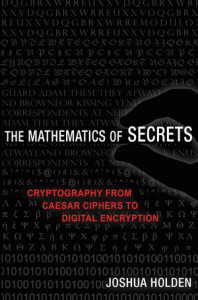 Ten days ago we posted a cryptogram puzzle, set by mathematician and author Josh Holden. We’ve had a number of entries, some which were so enthusiastic they ignored that we’d said to email them in and tried to post in the comments. However, from the correctly submitted entries, we had one stand-out winner – a quick reply, with a detailed description of the solution and a worthy recipient of a copy of The Mathematics of Secrets. Here’s Josh’s explanation of the puzzle, for anyone who hasn’t cracked it yet.
Ten days ago we posted a cryptogram puzzle, set by mathematician and author Josh Holden. We’ve had a number of entries, some which were so enthusiastic they ignored that we’d said to email them in and tried to post in the comments. However, from the correctly submitted entries, we had one stand-out winner – a quick reply, with a detailed description of the solution and a worthy recipient of a copy of The Mathematics of Secrets. Here’s Josh’s explanation of the puzzle, for anyone who hasn’t cracked it yet.
You're reading: Posts Tagged: competition
Competition: Cryptogram Puzzle
 Author and mathematician Josh Holden has come up with a nice puzzle — so we’re posting it as a competition. If you think you can decrypt the message below, send in the decrypted message and a one- or two-sentence description of the mathematical principle behind the encryption key to root@aperiodical.com. The first correct entry received will win a copy of Josh’s book, The Mathematics of Secrets.
Author and mathematician Josh Holden has come up with a nice puzzle — so we’re posting it as a competition. If you think you can decrypt the message below, send in the decrypted message and a one- or two-sentence description of the mathematical principle behind the encryption key to root@aperiodical.com. The first correct entry received will win a copy of Josh’s book, The Mathematics of Secrets.
The technical name for the “cryptograms” found in many newspapers and magazines is monoalphabetic monographic substitution ciphers — monographic meaning that they make substitutions one letter at a time and monoalphabetic meaning that the substitution rule is the same every time a given letter appears in the message.
Most often the easiest way to start solving these is to look at one-letter words which are usually “I” or “a”, then two-letter words, etc. If the breaks between the words are removed, then you might use the fact that in a typical English text the letter “e” will occur about 13% of the time, followed by “t” and “a” at 7-8% and others farther behind.
What then should we make of the following cryptogram?
YOFQX RGLQT GCQPB FFGQJ IQOFT SYVQH FSFQV FTYFC QJGQY OFRSQ YOSJG FQHOF GQYOF NQTSS REFCQ HRYOQ TQLSF TYQZS JHCQT VVFDW AFCQT WJBYQ YOFDQ TAAQV JSYVQ JIQAR YYAFQ WRSCV QTGCQ WFTVY VQTVQ HFAAQ TVQYO FQHOJ AFQMT ZXQJI QZTSC VQYOF QXGTE FQHTV QVYTG CRGLQ WFIJS FQYOF DQRGQ ZOTRG VQHRY OQTQV JACRF SQJGQ FTZOQ VRCFQ YJQLB TSCQO RDQTG CQGFT SQYOF QXRGL QHTVQ YOFQH ORYFQ STWWR YQHRY OQTQY SBDMF YQRGQ JGFQO TGCQT GCQTQ VZSJA AQJIQ MTSZO DFGYQ RGQYO FQJYO FS
The letter “Q” appears almost 20% of the time, followed by “F” at about 10%, and “Y” and “T” at about 8%. The original text is English (in fact it’s from a famous work of children’s literature) and it doesn’t have a particularly odd distribution of letters. Can you decrypt the message? For bonus points, can you figure out what is mathematically interesting about the encryption key?
The competition I entered into the first MathsJam Competition Competition
A couple of weekends ago was the big MathsJam gathering (I might call it a recreational maths conference, but this is discouraged). Two of the delightful sideshows, alongside an excellent series of talks, were the competitions. The Baking Competition is fairly straightforward, with prizes for “best flavour, best presentation, and best maths”:
The first will reward a well-made, delicious item; the second will reward the item which has been decorated the most beautifully and looks most like what it’s supposed to be; and the third will reward the most ingenious mathematical theming.
You can view the entries from this year on the MathsJam website.
RSS Stat of the Year

The Royal Statistical Society is seeking nominations for the best statistic of 2017 – they’re looking for the “statistics that you think really capture the year so far”. The nomination form (docx) can be downloaded from their website, and their criteria include that it should be accurate, coherent and not misleading, and that it should have a public interest dimension (but it doesn’t need to have already had media attention).
The judging panel is chaired by Professor Sir David Spiegelhalter and includes journalists, statisticians, economists and pollsters. The winning statistic will be unveiled in December.
More information
Stat of the Year, on the RSS Website
MathsBombe and Alan Turing Cryptography Competitions 2017 – registration open
Registration for the 2017 Alan Turing Cryptography Competition is now open!
The Aperiodical’s Actual Snowflake Competition – Results
Before Christmas, we launched a winter-themed maths competition – to design a sensible hexagonal snowflake, using a square grid, which could be used to knit a wintery jumper and not a) look terrible or b) have non-hexagonal symmetry. We had a deluge of entries, some valid and others less so – in fact, we may have had at least one entry break each of the rules we set. Below is a round-up of all the entries we received.
The Aperiodical’s Actually Hexagonal Snowflake Competition 2015

COMPETITION DEADLINE EXTENDED – SEE BELOW!
To celebrate the year end, as well as our daily Advent Calendar posts, we’re also running a little competition – last year we did a pun competition, and this year it’s something a bit more crafty – well, it’s a knitting competition in which the knitting is optional.